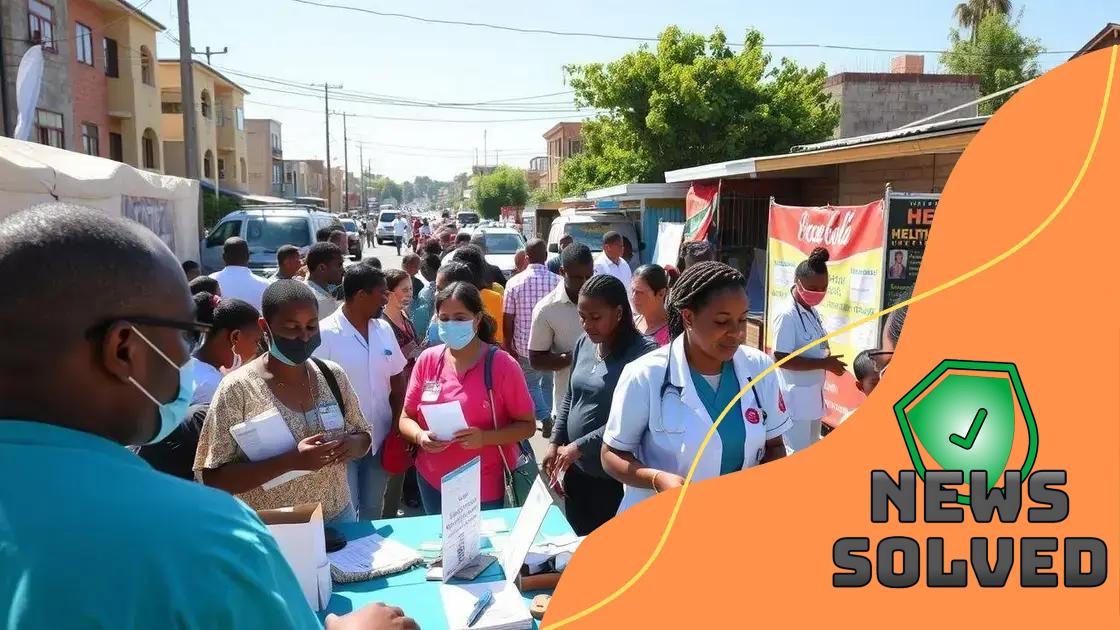The future of Medicaid expansion under new legislation

Advertisements
The future of Medicaid expansion under new legislation aims to enhance healthcare access for low-income individuals, improve health outcomes, and address critical challenges through innovative policies and community engagement.
The future of Medicaid expansion under new legislation is a topic sparking discussions across the nation. As states navigate new policies, understanding the potential outcomes can shape healthcare access for millions. Let’s explore these changes and what they mean for you.
Advertisements
Understanding Medicaid expansion
Understanding Medicaid expansion is vital for grasping how healthcare access can change in the United States. This program aims to assist low-income individuals and families, ensuring they receive necessary care. By expanding Medicaid, states can provide essential services that improve public health and reduce financial burdens.
What is Medicaid?
Medicaid is a government program that offers health coverage to eligible individuals. It primarily benefits low-income adults, children, pregnant women, elderly people, and those with disabilities. Each state runs its Medicaid program, with different rules and benefits.
Goals of Medicaid Expansion
The goal is to provide coverage to millions more individuals. States can expand Medicaid under the Affordable Care Act (ACA). This expansion aims to:
Advertisements
- Increase healthcare access for low-income adults
- Reduce the number of uninsured individuals
- Enhance preventive care and reduce emergency room visits
By offering coverage to a broader population, Medicaid expansion can improve overall health outcomes. It leads to better management of chronic conditions, like diabetes and hypertension.
It’s also important to understand the effect on state economies. States that expanded Medicaid experienced reductions in uncompensated care costs, meaning hospitals and clinics have less unpaid medical debt. An improved healthcare system supports local economies by keeping medical facilities open and employing healthcare professionals.
Who Benefits?
The beneficiaries of Medicaid expansion include working individuals who earn too much to qualify for traditional Medicaid but too little to afford private insurance. This demographic plays a crucial role in the workforce. Their health impacts not just their lives but also their families and communities.
Furthermore, Medicaid expansion plays a pivotal role for individuals battling addiction or mental health issues. By providing comprehensive treatment options, it fosters recovery and reintegration into society. This approach emphasizes that health is a collective community issue, not just an individual concern.
In conclusion, by grasping Medicaid expansion, we can appreciate its critical role in shaping healthcare accessibility in America. Understanding these changes inspires informed discussions on future healthcare policies.
Key changes in the new legislation
Understanding the key changes in the new legislation surrounding Medicaid expansion is essential for grasping its impacts on healthcare access. With recent modifications, states have gained new flexibility in their Medicaid programs. These changes aim to improve coverage and health outcomes for millions.
Expansion of Eligibility
One significant change is the expansion of eligibility criteria. Under the new law, more low-income individuals can qualify for coverage. Specifically, states can now raise the income limits for Medicaid eligibility, allowing those who previously fell through the cracks to enroll.
Enhanced Funding
Another vital aspect is the increase in federal funding. The government now provides greater financial assistance to states that opt to expand Medicaid. This funding helps cover the costs of the newly eligible individuals and alleviates financial pressures on local governments. With this boost, states can also invest in health initiatives.
- States can receive higher reimbursement rates for new enrollees.
- Incentives for preventive care services are introduced.
- Funding for mental health and substance use disorder services has increased.
Furthermore, the legislation emphasizes the need for states to address social determinants of health. This approach recognizes that factors like housing, transportation, and education significantly affect overall health. States are encouraged to develop programs that address these issues, leading to better health outcomes for covered individuals.
As Medicaid expands, the process for enrollment has also streamlined. Simplified applications and automatic renewals are being implemented, making access easier for families in need. Technology is playing a key role in reaching out to those eligible for Medicaid.
Protecting Against Cuts
Finally, the new legislation includes provisions to protect against cuts in coverage. States must adhere to specific guidelines to maintain the enhanced benefits and cannot reduce eligibility without federal approval. This stability is crucial for ensuring ongoing access to services for vulnerable populations.
By staying informed about these key changes, individuals can better navigate their healthcare options and advocate for their needs. Awareness of these modifications not only empowers those directly affected but also encourages community engagement around healthcare policies.
Impact on low-income communities

The impact on low-income communities due to Medicaid expansion is profound and far-reaching. Access to affordable healthcare can change lives, especially for families struggling to make ends meet. When these communities gain health coverage, it opens doors to better health outcomes and economic stability.
Access to Essential Services
Medicaid expansion allows more low-income individuals to receive necessary services. This includes preventive care, outpatient services, and hospital visits. With more people utilizing these services, the overall health of the community can improve. Diagnosing and treating health issues early can prevent more severe problems down the line.
Economic Benefits
Healthier communities are often more productive. When people have access to healthcare, they can work and contribute to the economy. This leads to lower rates of absenteeism in the workplace. As families save on healthcare costs, they can invest in education and other essential needs.
- Parents can take their children to regular check-ups.
- Individuals are less likely to delay treatment, reducing emergency room visits.
- Reduced financial stress related to healthcare expenses allows families to focus on other priorities.
Furthermore, community health centers benefit from an influx of patients, which helps sustain their operations. These centers become hubs for health and wellness, providing crucial resources and support. By increasing funding for mental health services, the legislation also addresses the social and emotional needs of residents.
Not only does Medicaid expansion provide coverage, but it also fosters a sense of safety and security within these communities. Families can focus on building their lives without the constant worry of medical debt. This empowerment helps create vibrant neighborhoods where residents can thrive.
Long-term Effects
The long-term effects of Medicaid expansion on low-income communities can be transformative. As residents receive necessary care, they can experience improved health outcomes. This leads to a decrease in chronic health conditions and an overall enhanced quality of life.
In addition, with a healthier population, local economies can flourish. Lower healthcare costs for families contribute to spending in other areas, boosting local businesses. Medicaid expansion is an investment in a community’s future, leading to positive changes that resonate for generations.
Challenges ahead for program implementation
Despite the benefits of Medicaid expansion, there are numerous challenges ahead for program implementation that states must navigate. These obstacles can impact how effectively the program meets the needs of low-income individuals and families.
Funding Uncertainties
One of the primary challenges is securing consistent funding. While initial federal support is available, many states worry about what happens once this funding decreases or expires. This uncertainty can lead to difficult decisions about cutbacks to services that people depend on.
Bureaucratic Hurdles
Navigating the bureaucratic landscape is another significant challenge. States need to develop new systems to manage increased enrollment. Ensuring that all eligible individuals understand their options and can easily enroll is essential. Often, this requires training staff and updating technology.
- States must create simplified application processes.
- Outreach initiatives are necessary to educate the public.
- Monitoring and compliance measures must be implemented to prevent fraud.
Moreover, many states face staff shortages in healthcare and social services. This scarcity can slow the implementation process and strain existing workers. As a result, timely assistance and support for new enrollees may not be met during the initial phases of the program.
Political Opposition
Political opposition can also pose a significant barrier. In some regions, local leaders may disagree with Medicaid expansion or fear its implications. This division can affect policy decisions and public opinion. Advocacy groups play a vital role in combatting misinformation and promoting the advantages of expansion.
Additionally, managing the public’s expectations is crucial. Many eligible individuals may not fully understand the changes or may not realize they qualify for benefits. Clear communication is needed to convey how these changes can positively impact their lives.
Integration with Other Services
Lastly, integrating Medicaid expansion with other essential services remains a challenge. Coordination between healthcare providers, welfare services, and community organizations is necessary to create a comprehensive support system. Without this integration, beneficiaries may struggle to navigate multiple systems.
In summary, while Medicaid expansion holds significant promise, various challenges must be addressed. States and communities must work collaboratively to overcome these hurdles, ensuring the program’s success for all individuals in need.
Future prospects and policy recommendations
The future prospects and policy recommendations for Medicaid expansion are essential in shaping the healthcare landscape for millions. As the program evolves, it is crucial for policymakers to consider innovative strategies that enhance access and address the needs of vulnerable populations.
Leveraging Technology
One promising prospect is the integration of technology to streamline enrollment processes. By improving online application systems, states can make it easier for individuals to access Medicaid. This can also involve using mobile applications for reminders about appointments, renewals, and health tips.
Community Engagement
Another key recommendation is to focus on community engagement. States can form partnerships with local organizations to raise awareness about available resources. These partnerships can help reach underserved populations and ensure that everyone knows how to access Medicaid services.
- Conduct community health fairs to provide information about enrollment.
- Utilize social media campaigns to share stories of successful enrollees.
- Offer workshops to educate families about their healthcare options.
Furthermore, it is vital to address the social determinants of health through targeted policy initiatives. Programs should not only focus on providing healthcare but also enhancing living conditions and access to education. By tackling issues like food insecurity and housing stability, policymakers can create a more comprehensive approach to health.
Expanding Workforce Training
Investing in workforce training for healthcare providers is another crucial area. Ensuring that providers are trained in cultural competency can improve patient interactions. This awareness helps in delivering better care tailored to the diverse needs of communities.
Additionally, implementing data-driven decision-making can greatly enhance policy effectiveness. By using analytics to monitor health outcomes, states can identify gaps in services and adjust their strategies accordingly. This data-driven approach can lead to more efficient program management and improved patient care.
Ensuring Sustainability
Finally, sustainability should be a cornerstone of any future policies. Securing long-term funding through federal and state collaboration is vital. The focus should be on creating a healthcare system that is both accessible and financially viable for future generations.
Incorporating these recommendations can pave the way for a more effective Medicaid expansion program. As communities benefit from better access to care, the overall health of the population will improve, creating a ripple effect that supports economic stability and quality of life.
FAQ – Frequently Asked Questions about Medicaid Expansion
What is Medicaid expansion?
Medicaid expansion is a provision that allows states to extend their Medicaid programs to cover more low-income individuals and families, improving healthcare access.
How does Medicaid expansion benefit low-income communities?
It increases access to essential healthcare services, reducing the number of uninsured individuals and improving overall health outcomes in those communities.
What challenges do states face in implementing Medicaid expansion?
States may encounter funding uncertainties, bureaucratic hurdles, political opposition, and challenges in integrating services for beneficiaries.
What are some future recommendations for Medicaid expansion?
Important recommendations include leveraging technology for enrollment, engaging communities to raise awareness, and investing in workforce training to improve healthcare delivery.





